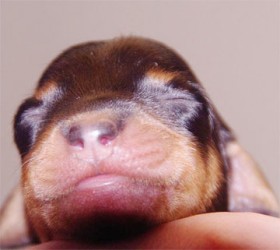Continued
The week before last we spoke of skin infections of the young pup. I should have added to the list of treatment possibilities a recipe that can be used in cases of minor skin rashes. You can cleanse the scabs with a dilute solution (1 per cent) of hydrogen peroxide and then wash off with a surgical soap. Then you can apply an antibiotic ointment to the skin where the damage appears.
Ailment of the eye
Now let’s look today at eye problems of the newborn. First of all we must know that the eyelids of puppies remain closed for 10-14 days after birth. So don’t go trying to prise them open.
Certain breeds have long hairs around the eyes, and these hairs rub on the eyeball creating a soreness and thus laying  the groundwork for a later bacterial infection. In the young pup, practically all of the eye problems are associated with infection. This ailment is known as a conjunctivitis of the newborn (scientific name: Opthalmia neonatorum).
the groundwork for a later bacterial infection. In the young pup, practically all of the eye problems are associated with infection. This ailment is known as a conjunctivitis of the newborn (scientific name: Opthalmia neonatorum).
Since the eyelids do not open for the first 10-14 days, there is therefore a closed space behind the eyelids (between the eyelids and the eyeball). In this closed space, once germs get in, they will multiply into a full-fledged infection. These germs can get into the space via the bloodstream of the puppy, or if there is a small aperture created by, say, a scratch from a littermate while fighting for a nipple to suckle from.
Symptoms
The pup’s eyes look swollen and puffy, since a lot of pus might be accumulating behind the eyelid.
If the pup has a white or light coloured face, one can actually see redness around the closed eye. If there is a small gap between the top and bottom eyelids, there might be some discharge (even cream coloured pus). Let it be clear:
 Any discharge, pussy or not, from the pup’s eyes might be considered abnormal. If the condition is allowed to progress, the pup will become listless and might even cease to suckle. It will show signs of discomfort and be crying all the time.
Any discharge, pussy or not, from the pup’s eyes might be considered abnormal. If the condition is allowed to progress, the pup will become listless and might even cease to suckle. It will show signs of discomfort and be crying all the time.
Treatment
The important thing is to get the accumulated pussy material out of the space between the eyeball and the eyelids. This means that you will have to pry open the eyelids.
If you feel uncomfortable doing this, let your vet open up the eyelids.
Of course, one has to proceed very carefully so as not to cause any permanent damage to the eyeball. The separation must not be a rough tearing apart of the two lids; rather the lids bluntly separated perhaps with the help of a flat teaspoon handle.
After the lids have been gently prised apart, you have to flush away the contaminated liquid, pussy mass. The puss will come out easy in droplets. There will be some residue after the first flushing. This must not be allowed to remain. Flush again. The flushing solution could be an off-the-shelf eyewash (eg, Optrex Eye Lotion, Clear Eyes, Murine Eye Drops and the like). Or, you can make your own solution of boiled water into which you place some Borax crystals.
After the flushing, it is important that the eyelids are not allowed to glue themselves back shut. Since you will be flushing the eyes at least thrice daily, there is little likelihood that the eyelids will close again.
After every flushing, antibiotic eye drops should be administered under veterinary advice.
Please implement disease preventative measures (vaccinations, routine dewormings, monthly anti-heartworm medication, etc) and adopt-a-pet from the GSPCA’s Animal Clinic and Shelter at Robb Street and Orange Walk, if you have the wherewithal to care well for the animals. Do not stray your unwanted pets, take them to the GSPCA’s Clinic and Shelter instead. If you do not wish your pet to have puppies or kittens, you may exploit the GSPCA’s free spay and neutering programme. If you see anyone being cruel to an animal, or if you need any technical information, please get in touch with the Clinic and Shelter by calling 226-4237.







